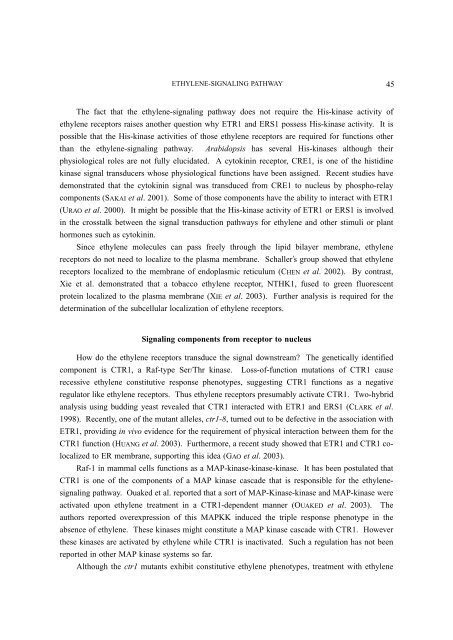No.42 - è¾²æ¥çç©è³æºç 究æ
No.42 - è¾²æ¥çç©è³æºç 究æ
No.42 - è¾²æ¥çç©è³æºç 究æ
You also want an ePaper? Increase the reach of your titles
YUMPU automatically turns print PDFs into web optimized ePapers that Google loves.
ETHYLENE-SIGNALING PATHWAY<br />
45<br />
The fact that the ethylene-signaling pathway does not require the His-kinase activity of<br />
ethylene receptors raises another question why ETR1 and ERS1 possess His-kinase activity. It is<br />
possible that the His-kinase activities of those ethylene receptors are required for functions other<br />
than the ethylene-signaling pathway. Arabidopsis has several His-kinases although their<br />
physiological roles are not fully elucidated. A cytokinin receptor, CRE1, is one of the histidine<br />
kinase signal transducers whose physiological functions have been assigned. Recent studies have<br />
demonstrated that the cytokinin signal was transduced from CRE1 to nucleus by phospho-relay<br />
components (SAKAI et al. 2001). Some of those components have the ability to interact with ETR1<br />
(URAO et al. 2000). It might be possible that the His-kinase activity of ETR1 or ERS1 is involved<br />
in the crosstalk between the signal transduction pathways for ethylene and other stimuli or plant<br />
hormones such as cytokinin.<br />
Since ethylene molecules can pass freely through the lipid bilayer membrane, ethylene<br />
receptors do not need to localize to the plasma membrane. Schaller’s group showed that ethylene<br />
receptors localized to the membrane of endoplasmic reticulum (CHEN et al. 2002). By contrast,<br />
Xie et al. demonstrated that a tobacco ethylene receptor, NTHK1, fused to green fluorescent<br />
protein localized to the plasma membrane (XIE et al. 2003). Further analysis is required for the<br />
determination of the subcellular localization of ethylene receptors.<br />
Signaling components from receptor to nucleus<br />
How do the ethylene receptors transduce the signal downstream? The genetically identified<br />
component is CTR1, a Raf-type Ser/Thr kinase. Loss-of-function mutations of CTR1 cause<br />
recessive ethylene constitutive response phenotypes, suggesting CTR1 functions as a negative<br />
regulator like ethylene receptors. Thus ethylene receptors presumably activate CTR1. Two-hybrid<br />
analysis using budding yeast revealed that CTR1 interacted with ETR1 and ERS1 (CLARK et al.<br />
1998). Recently, one of the mutant alleles, ctr1-8, turned out to be defective in the association with<br />
ETR1, providing in vivo evidence for the requirement of physical interaction between them for the<br />
CTR1 function (HUANG et al. 2003). Furthermore, a recent study showed that ETR1 and CTR1 colocalized<br />
to ER membrane, supporting this idea (GAO et al. 2003).<br />
Raf-1 in mammal cells functions as a MAP-kinase-kinase-kinase. It has been postulated that<br />
CTR1 is one of the components of a MAP kinase cascade that is responsible for the ethylenesignaling<br />
pathway. Ouaked et al. reported that a sort of MAP-Kinase-kinase and MAP-kinase were<br />
activated upon ethylene treatment in a CTR1-dependent manner (OUAKED et al. 2003). The<br />
authors reported overexpression of this MAPKK induced the triple response phenotype in the<br />
absence of ethylene. These kinases might constitute a MAP kinase cascade with CTR1. However<br />
these kinases are activated by ethylene while CTR1 is inactivated. Such a regulation has not been<br />
reported in other MAP kinase systems so far.<br />
Although the ctr1 mutants exhibit constitutive ethylene phenotypes, treatment with ethylene













